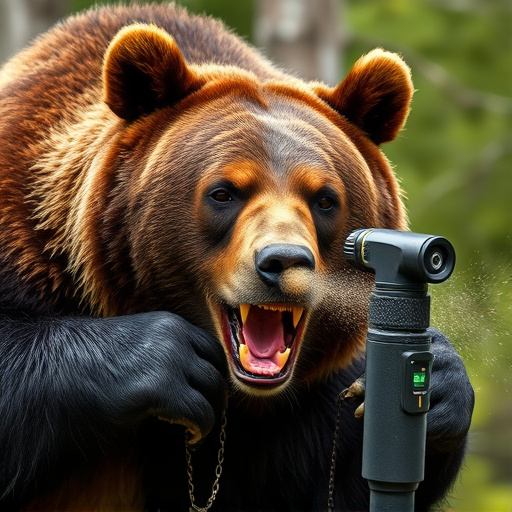Bears pose risks to hikers and campers, with attacks driven by threats or surprises. Preventing encounters involves understanding bear behavior and timing. During unexpected close encounters in areas where bears are attracted by human food or garbage, properly using bear spray (e.g., aiming for face and eyes from 20-25 feet away) can deter aggressive behavior like charging. Bear spray isn't a guarantee of safety but significantly increases the chances of avoiding attacks. Effective use requires understanding the technique, aiming at sensitive areas, and employing it as a last resort. When venturing into bear country, combining bear spray with other safety measures, such as securing food and making noise, enhances overall protection.
In wilderness survival, understanding bear behavior is paramount. While attacks are rare, knowing when and where they occur can save lives. This guide delves into effective strategies for protection against bear attacks, with a focus on the crucial role of bear spray. From understanding bear behavior to mastering application techniques and exploring additional safety measures, learn the essential skills to navigate these encounters safely. Discover the best practices for using bear spray properly and enhance your wilderness survival chances.
- Understanding Bear Behavior: When and Where Attacks Occur
- Types of Bear Spray and Their Effectiveness
- Application Technique: Ensuring Maximum Protection
- Additional Safety Measures Beyond Bear Spray
Understanding Bear Behavior: When and Where Attacks Occur
Bears, both black and grizzly, are powerful animals that inhabit many wilderness areas worldwide. Understanding their behavior is crucial for hikers and campers to minimize risks during encounters. These attacks are not random; they often occur when a bear feels threatened or surprised, especially when protecting its young or food sources. Knowing the timing and locations of potential incidents can help prevent them.
In terms of when to use bear spray properly, it’s essential to employ this technique during unexpected close encounters with bears. This is particularly relevant in areas where bears are attracted by human food or garbage. When a bear exhibits aggressive behavior, like charging or making loud noises, spraying it with bear repellent can create a barrier and deter the attack. Proper usage involves aiming for the bear’s face and eyes while keeping a safe distance.
Types of Bear Spray and Their Effectiveness
Bear spray is a popular and effective tool for protecting against bear attacks, but understanding its types and proper usage is crucial. There are two main types available: oleoresin capsicum (OC) and alpha-pinene. OC spray is derived from chili peppers and is known for its strong irritant properties, causing bears to recoil and temporarily disable them. Alpha-pinene spray, on the other hand, uses essential oils and natural compounds, offering a slightly milder but still effective deterrent.
When to use bear spray properly? It’s recommended for close encounters when a bear is standing upright, showing aggression or defensive behavior. Spraying from a safe distance, typically 20-25 feet away, creates an aerosol barrier that can reach the bear’s eyes and face. However, in extreme cases where direct eye contact is made, a quick burst of spray directly towards the bear’s face is advised. Remember, bear spray is not a guarantee of safety but significantly increases your chances of avoiding or mitigating a potential attack.
Application Technique: Ensuring Maximum Protection
When it comes to protecting yourself from bear attacks in the wilderness, one of the most effective tools at your disposal is bear spray. However, its success depends on proper application technique. It’s crucial to understand when and how to use it effectively. Bear spray should be employed as a last resort, when you’re faced with an aggressive or defensive bear. Aim for the face and eyes, which are sensitive areas. This is where the spray creates maximum discomfort, temporarily blinding and disorienting the bear, allowing you an escape route.
Practice using bear spray in controlled environments to familiarize yourself with its range and effect. Ensure it’s within reach but not obstructing your path or line of sight during a potential encounter. Regularly inspect the can for damage or expiration date. In terms of distance, aim for about 20-30 feet (6-9 meters) away from the bear, allowing enough time to activate and disperse before reaching you. Remember, proper usage combined with other survival skills is key to navigating encounters in the wild.
Additional Safety Measures Beyond Bear Spray
When venturing into bear country, it’s crucial to understand that no single method guarantees 100% protection against a bear attack. While bear spray remains an essential tool, especially when encountering aggressive or defensive bears, there are additional safety measures to consider for comprehensive protection. Knowledge and awareness are your first lines of defense; understanding bear behavior, their habitats, and the situations that might trigger an attack can help prevent conflicts.
Moreover, physical barriers like sturdy shelters or bear-resistant containers can provide a safe haven in case of an encounter. Proper food storage is also vital; securing food properly reduces the likelihood of attracting bears to your camp or campsite. Additionally, making noise while traveling through bear terrain, especially during dawn and dusk, can deter bears from approaching unexpectedly. These measures, combined with the correct use of bear spray when necessary, offer a multi-layered approach to enhancing safety in bear country.
In wilderness survival scenarios, understanding bear behavior and knowing when to use bear spray properly are key to protecting yourself. By recognizing attack patterns and mastering the application technique of bear spray, you can significantly enhance your safety in bear country. Remember, while bear spray is a powerful tool, it’s just one component of a comprehensive safety strategy that includes awareness, noise management, and understanding habitat. With the right preparation and knowledge, you can enjoy a safer, more secure experience amidst the wilderness.
